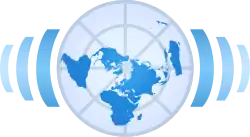Portal:Washington, D.C.
Portal maintenance status: (No date set)
|
The Washington, D.C. portal
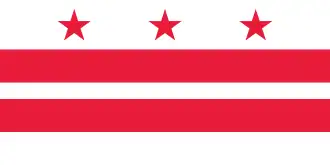
Washington, D.C., officially the District of Columbia and commonly known as simply Washington or D.C., is the capital city and federal district of the United States. The city is on the Potomac River, across from Virginia, and shares land borders with Maryland to its north and east. It was named after George Washington, the first president of the United States. The district is named for Columbia, the female personification of the nation.
The U.S. Constitution in 1789 called for the creation of a federal district under exclusive jurisdiction of the U.S. Congress. As such, Washington, D.C., is not part of any state, and is not one itself. The Residence Act, adopted on July 16, 1790, approved the creation of the capital district along the Potomac River. The city was founded in 1791, and the 6th Congress held the first session in the unfinished Capitol Building in 1800 after the capital moved from Philadelphia. In 1801, the District of Columbia, formerly part of Maryland and Virginia and including the existing settlements of Georgetown and Alexandria, was officially recognized as the federal district; initially, the city was a separate settlement within the larger district. In 1846, Congress reduced the size of the district when it returned the land originally ceded by Virginia, including the city of Alexandria. In 1871, it created a single municipality for the district. There have been several unsuccessful efforts to make the district into a state since the 1880s, including a statehood bill that passed the House of Representatives in 2021 but was not adopted by the U.S. Senate.
Washington, D.C., anchors the southern end of the Northeast megalopolis. As the seat of the U.S. federal government, the city is an important world political capital. The city hosts buildings that house federal government headquarters, including the White House, U.S. Capitol, Supreme Court Building, and multiple federal departments and agencies. The city is home to many national monuments and museums, located most prominently on or around the National Mall, including the Jefferson Memorial, Lincoln Memorial, and Washington Monument. It hosts 177 foreign embassies and the global headquarters of the World Bank, International Monetary Fund, Organization of American States, and other international organizations. Home to many of the nation's largest industry associations, non-profit organizations, and think tanks, the city is known as a lobbying hub, which is centered on and around K Street. It is also among the country's top tourist destinations; in 2022, it drew an estimated 20.7 million domestic and 1.2 million international visitors, seventh-most among U.S. cities. (Full article...)
 Featured article
Featured article
-
 Image 1
Image 1.jpg) Isabel making landfall in North Carolina on September 18
Isabel making landfall in North Carolina on September 18
In Maryland and Washington, D.C., the effects of Hurricane Isabel were among the most damaging from a tropical cyclone in the respective metropolitan area. Hurricane Isabel formed from a tropical wave on September 6, 2003, in the tropical Atlantic Ocean. It moved northwestward, and within an environment of light wind shear and warm waters, it steadily strengthened to reach peak winds of 165 miles per hour (266 km/h) on September 11. After fluctuating in intensity for four days, Isabel gradually weakened and made landfall on the Outer Banks of North Carolina with winds of 105 miles per hour (169 km/h) on September 18. It quickly weakened over land and became extratropical over western Pennsylvania the next day. (Full article...) -
 Image 2
Image 2.jpg) Portrait c. 1835
Portrait c. 1835
Andrew Jackson (March 15, 1767 – June 8, 1845) was the seventh president of the United States from 1829 to 1837. He rose to fame as a U.S. Army general and served in both houses of the U.S. Congress. His political philosophy, which dominated his presidency, became the basis for the rise of Jacksonian democracy. Jackson's legacy is controversial: he has been praised as an advocate for working Americans and preserving the union of states, and criticized for his racist policies, particularly towards Native Americans. (Full article...) -
 Image 3
Image 3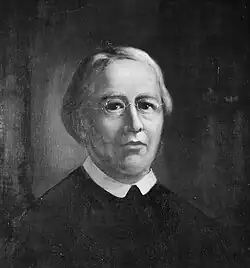
William Feiner SJ (born Wilhelm Feiner; December 27, 1792 – June 9, 1829) was a German Catholic priest and Jesuit who became a missionary to the United States and eventually the president of Georgetown College, now known as Georgetown University. (Full article...) -
![Image 4 1816 portrait James Madison (March 16, 1751 [O.S. March 5, 1750] – June 28, 1836) was an American statesman, diplomat, and Founding Father who served as the fourth president of the United States from 1809 to 1817. Madison was popularly acclaimed as the "Father of the Constitution" for his pivotal role in drafting and promoting the Constitution of the United States and the Bill of Rights. (Full article...)](./_assets_/Blank.png) Image 4
Image 4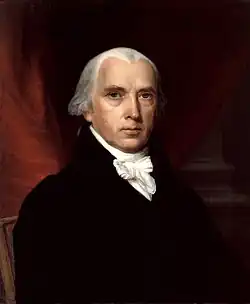 1816 portrait
1816 portrait
James Madison (March 16, 1751 [O.S. March 5, 1750] – June 28, 1836) was an American statesman, diplomat, and Founding Father who served as the fourth president of the United States from 1809 to 1817. Madison was popularly acclaimed as the "Father of the Constitution" for his pivotal role in drafting and promoting the Constitution of the United States and the Bill of Rights. (Full article...) -
 Image 5
Image 5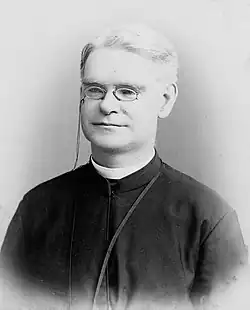 Doonan in 1890
Doonan in 1890
James Aloysius Doonan SJ (November 8, 1841 – April 12, 1911) was an American Catholic priest and Jesuit, who was the president of Georgetown University from 1882 to 1888. During that time he oversaw the naming of Gaston Hall and the construction of a new building for the School of Medicine. Doonan also acquired two historic cannons that were placed in front of Healy Hall. His presidency was financially successful, with a reduction in the university's burdensome debt that had accrued during the construction of Healy Hall. (Full article...) -
 Image 6
Image 6
Stephen Colbert and his wife, Evelyn McGee, at the Time 100 most influential people awards for 2006
On April 29, 2006, American comedian Stephen Colbert appeared as the featured entertainer at the 2006 White House Correspondents' Association Dinner, which was held in Washington, D.C., at the Hilton Washington hotel. Colbert's performance, consisting of a 16-minute podium speech and a 7-minute video presentation, was broadcast live across the United States on the cable television networks C-SPAN and MSNBC. Standing a few feet from U.S. President George W. Bush, in front of an audience of celebrities, politicians, and members of the White House Press Corps, Colbert delivered a controversial satirical routine targeting the president and the media. He spoke in the persona of the character he played on Comedy Central's The Colbert Report, a parody of conservative pundits such as Bill O'Reilly and Sean Hannity. (Full article...) -
 Image 7
Image 7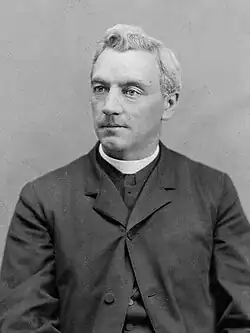 Healy in 1882
Healy in 1882
Patrick Francis Healy SJ (February 27, 1834 – January 10, 1910) was an American Catholic priest and Jesuit who was an influential president of Georgetown University, becoming known as its "second founder". The university's flagship building, Healy Hall, bears his name. Though he considered himself and was widely accepted as White, Healy was posthumously recognized as the first Black American to earn a PhD, as well as the first to enter the Jesuit order and to become the president of a predominantly White university. (Full article...) -
 Image 8
Image 8
The first inauguration of Barack Obama as the 44th president of the United States took place on Tuesday, January 20, 2009, at the West Front of the United States Capitol in Washington, D.C. The 56th inauguration, which set a record attendance for any event held in the city, marked the commencement of the first term of Barack Obama as president and Joe Biden as vice president. Based on combined attendance numbers, television viewership, and Internet traffic, it was the most viewed inauguration since that of Ronald Reagan in 1981. (Full article...) -
 Image 9
Image 9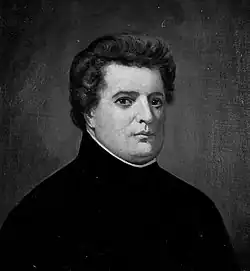
Thomas F. Mulledy SJ (/mʌˈleɪdi/ muh-LAY-dee; August 12, 1794 – July 20, 1860) was an American Catholic priest and Jesuit who became the president of Georgetown College, a founder of the College of the Holy Cross, and a Jesuit provincial superior. His brother, Samuel Mulledy, also became a Jesuit and president of Georgetown. (Full article...) -
 Image 10
Image 10 David Hillhouse Buel in 1908
David Hillhouse Buel in 1908
David Hillhouse Buel Jr. (July 19, 1862 – May 23, 1923) was an American priest who served as the president of Georgetown University. A Catholic priest and Jesuit for much of his life, he later left the Jesuit order to marry, and subsequently left the Catholic Church to become an Episcopal priest. Born at Watervliet, New York, he was the son of David Hillhouse Buel, a distinguished Union Army officer, and descended from numerous prominent New England families. While studying at Yale University, he formed an acquaintance with priest Michael J. McGivney, resulting in his conversion to Catholicism and joining the Society of Jesus after graduation. (Full article...) -
 Image 11
Image 11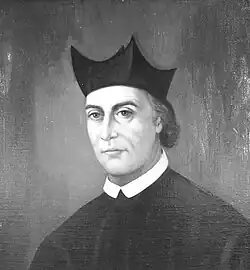
Joseph Anton Lopez SJ (born José Antonio López; October 4, 1779 – October 5, 1841) was a Mexican Catholic priest and Jesuit. Born in Michoacán, he studied canon law at the Colegio de San Nicolás and the Royal and Pontifical University of Mexico. He became acquainted with the future Empress consort Ana María Huarte and was made chaplain to the future imperial family. He was later put in charge of the education of all the princes in Mexico. Lopez was a close ally of Emperor Agustín de Iturbide, residing in Madrid for four years as his attorney and political informant, and accompanying him during his exile to Italy and England. (Full article...) -
 Image 12
Image 12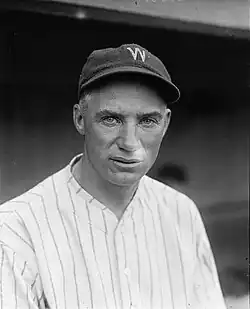 Coveleski with the Washington Senators in 1925
Coveleski with the Washington Senators in 1925
Stanley Anthony Coveleski (born Stanislaus Kowalewski, July 13, 1889 – March 20, 1984) was an American right-handed pitcher in Major League Baseball who played for four American League (AL) teams between 1912 and 1928, primarily the Cleveland Indians. The star of the Indians pitching staff, he won over 20 games each year from the war-shortened 1918 season through 1921, leading the AL in shutouts twice and in strikeouts and earned run average (ERA) once each during his nine years with the club. The star of the 1920 World Series, he led the Indians to their first title with three complete-game victories, including a 3–0 shutout in the Game 7 finale. Traded to the Washington Senators after the 1924 season, he helped that club to its second AL pennant in a row with 20 victories against only 5 losses, including a 13-game winning streak, while again leading the league in ERA. (Full article...) -
 Image 13
Image 13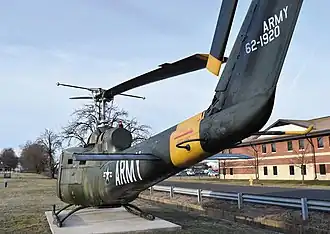 The stolen helicopter, now on display at NASJRB Willow Grove
The stolen helicopter, now on display at NASJRB Willow Grove
On February 17, 1974, U.S. Army Private First Class Robert Kenneth Preston (1953–2009) took off in a stolen Bell UH-1B Iroquois "Huey" helicopter from Tipton Field, Maryland, and landed it on the South Lawn of the White House in a significant breach of security. Preston had enlisted in the Army to become a helicopter pilot. However, he did not graduate from the helicopter training course and lost his opportunity to attain the rank of warrant officer pilot. His enlistment bound him to serve four years in the Army, and he was sent to Fort Meade as a helicopter mechanic. Preston believed this situation was unfair and later said he stole the helicopter to show his skill as a pilot. (Full article...) -
 Image 14Look Mickey (also known as Look Mickey!) is a 1961 oil on canvas painting by Roy Lichtenstein. Widely regarded as the bridge between his abstract expressionism and pop art works, it is notable for its ironic humor and aesthetic value as well as being the first example of the artist's employment of Ben-Day dots, speech balloons and comic imagery as a source for a painting. The painting was bequeathed to the Washington, D.C., National Gallery of Art upon Lichtenstein's death. (Full article...)
Image 14Look Mickey (also known as Look Mickey!) is a 1961 oil on canvas painting by Roy Lichtenstein. Widely regarded as the bridge between his abstract expressionism and pop art works, it is notable for its ironic humor and aesthetic value as well as being the first example of the artist's employment of Ben-Day dots, speech balloons and comic imagery as a source for a painting. The painting was bequeathed to the Washington, D.C., National Gallery of Art upon Lichtenstein's death. (Full article...) -
 Image 15
Image 15_(2).jpg) Portrait, c. 1849
Portrait, c. 1849
James Knox Polk (/poʊk/; November 2, 1795 – June 15, 1849) was the 11th president of the United States, serving from 1845 to 1849. A protégé of Andrew Jackson and a member of the Democratic Party, he was an advocate of Jacksonian democracy and American expansionism. Polk saw Texas join the Union in his first year in office, one of the precipitating causes that soon led the U.S. into the Mexican–American War. The settlement of that war expanded American territory to the Pacific Ocean. During his term, the dispute over the Oregon Territory, with Great Britain was also resolved, creating the present U.S.-Canadian boundary. (Full article...) -
 Image 16
Image 16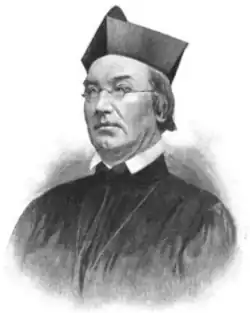
John Early SJ (July 1, 1814 – May 23, 1873) was an Irish-American Catholic priest and Jesuit educator who was the president of the College of the Holy Cross and Georgetown University, as well as the founder and first president of Loyola College in Maryland. Born in Ireland, he emigrated to the United States at the age of nineteen. Upon his arrival, he enrolled at Mount St. Mary's Seminary in Maryland and entered the Society of Jesus, completing his education at Georgetown University in Washington, D.C. (Full article...) -
 Image 17William Matthews (December 16, 1770 – April 30, 1854), occasionally spelled Mathews, was an American who became the fifth Roman Catholic priest ordained in the United States and the first such person born in British America. Born in the colonial Province of Maryland, he was briefly a novice in the Society of Jesus. After being ordained, he became influential in establishing Catholic parochial and educational institutions in Washington, D.C. He was the second pastor of St. Patrick's Church, serving for most of his life. He served as the sixth president of Georgetown College, later known as Georgetown University. Matthews acted as president of the Washington Catholic Seminary, which became Gonzaga College High School, and oversaw the continuity of the school during suppression by the church and financial insecurity. (Full article...)
Image 17William Matthews (December 16, 1770 – April 30, 1854), occasionally spelled Mathews, was an American who became the fifth Roman Catholic priest ordained in the United States and the first such person born in British America. Born in the colonial Province of Maryland, he was briefly a novice in the Society of Jesus. After being ordained, he became influential in establishing Catholic parochial and educational institutions in Washington, D.C. He was the second pastor of St. Patrick's Church, serving for most of his life. He served as the sixth president of Georgetown College, later known as Georgetown University. Matthews acted as president of the Washington Catholic Seminary, which became Gonzaga College High School, and oversaw the continuity of the school during suppression by the church and financial insecurity. (Full article...) -
![Image 18 John William Beschter SJ (born Johann Wilhelm Beschter; German: [ˈjoːhan ˈvɪlhɛlm ˈbɛʃtɐ]; May 20, 1763 – January 6, 1842) was a Catholic priest and Jesuit from the Duchy of Luxembourg in the Austrian Netherlands. He emigrated to the United States as a missionary in 1807, where he ministered in rural Pennsylvania and Maryland. Beschter was the last Jesuit pastor of St. Mary's Church in Lancaster, as well as the pastor of St. John the Evangelist Church in Baltimore, Maryland. He was also a priest at several other German-speaking churches in Pennsylvania. (Full article...)](./_assets_/Blank.png) Image 18
Image 18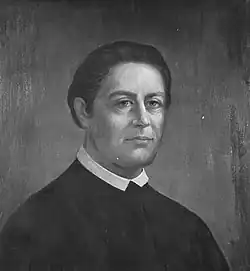
John William Beschter SJ (born Johann Wilhelm Beschter; German: [ˈjoːhan ˈvɪlhɛlm ˈbɛʃtɐ]; May 20, 1763 – January 6, 1842) was a Catholic priest and Jesuit from the Duchy of Luxembourg in the Austrian Netherlands. He emigrated to the United States as a missionary in 1807, where he ministered in rural Pennsylvania and Maryland. Beschter was the last Jesuit pastor of St. Mary's Church in Lancaster, as well as the pastor of St. John the Evangelist Church in Baltimore, Maryland. He was also a priest at several other German-speaking churches in Pennsylvania. (Full article...) -
 Image 19
Image 19.jpg)
James A. Ryder SJ (October 8, 1800 – January 12, 1860) was an American Catholic priest and Jesuit who became the president of several Jesuit universities in the United States. Born in Ireland, he immigrated with his widowed mother to the United States as a child, to settle in Georgetown, in the District of Columbia. He enrolled at Georgetown College and then entered the Society of Jesus. Studying in Maryland and Rome, Ryder proved to be a talented student of theology and was made a professor. He returned to Georgetown College in 1829, where he was appointed to senior positions and founded the Philodemic Society, becoming its first president. (Full article...) -
 Image 20Enoch Fenwick SJ (May 15, 1780 – November 25, 1827) was an American Catholic priest and Jesuit who ministered throughout Maryland and became the twelfth president of Georgetown College. Descending from one of the original Catholic settlers of the Province of Maryland, he studied at Georgetown College in what is now Washington, D.C. Like his brother and future bishop, Benedict Joseph Fenwick, he entered the priesthood, studying at St. Mary's Seminary before entering the Society of Jesus, which was suppressed at the time. He was made rector of St. Peter's Pro-Cathedral in Baltimore by Archbishop John Carroll, and remained in the position for ten years. Near the end of his pastorate, he was also made vicar general of the Archdiocese of Baltimore, which involved traveling to say Mass in remote parishes throughout rural Maryland. (Full article...)
Image 20Enoch Fenwick SJ (May 15, 1780 – November 25, 1827) was an American Catholic priest and Jesuit who ministered throughout Maryland and became the twelfth president of Georgetown College. Descending from one of the original Catholic settlers of the Province of Maryland, he studied at Georgetown College in what is now Washington, D.C. Like his brother and future bishop, Benedict Joseph Fenwick, he entered the priesthood, studying at St. Mary's Seminary before entering the Society of Jesus, which was suppressed at the time. He was made rector of St. Peter's Pro-Cathedral in Baltimore by Archbishop John Carroll, and remained in the position for ten years. Near the end of his pastorate, he was also made vicar general of the Archdiocese of Baltimore, which involved traveling to say Mass in remote parishes throughout rural Maryland. (Full article...) -
 Image 21
Image 21 Killebrew with the Minnesota Twins in 1962
Killebrew with the Minnesota Twins in 1962
Harmon Clayton Killebrew Jr. (/ˈkɪlɪbruː/; June 29, 1936 – May 17, 2011), nicknamed "the Killer" and "Hammerin' Harmon", was an American professional baseball first baseman, third baseman, and left fielder. He spent most of his 22-year career in Major League Baseball (MLB) with the Minnesota Twins. A prolific power hitter, Killebrew had the fifth-most home runs in major league history at the time of his retirement. He was second only to Babe Ruth in American League (AL) home runs, and was the AL career leader in home runs by a right-handed batter. Killebrew was inducted into the National Baseball Hall of Fame in 1984. (Full article...) -
 Image 22
Image 22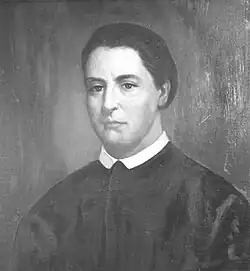
Samuel A. Mulledy SJ (/mʌˈleɪdi/ muh-LAY-dee; March 27, 1811 – January 8, 1866) was an American Catholic priest and Jesuit who served as president of Georgetown College in 1845. Born in Virginia, he was the brother of Thomas F. Mulledy, who was a prominent 19th-century Jesuit in the United States and a president of Georgetown. As a student at Georgetown, Samuel was one of the founding members of the Philodemic Society, and proved to be a distinguished student, which resulted in his being sent to Rome to complete his higher education and be ordained to the priesthood. Upon his return to the United States, he became the master of novices at the Jesuit novitiate in Maryland, before being named president of Georgetown. He sought to be relieved of the position after only a few months, and returned to teaching and ministry. (Full article...) -
 Image 23
Image 23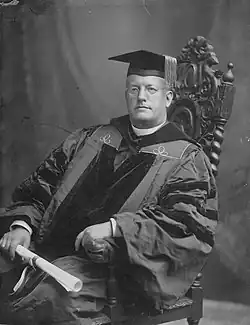 Whitney in 1906
Whitney in 1906
John Dunning Whitney SJ (July 19, 1850 – November 27, 1917) was an American Catholic priest and Jesuit who became the president of Georgetown University in 1898. Born in Massachusetts, he joined the United States Navy at the age of 16, where he was introduced to Catholicism by way of a book that accidentally came into his possession and prompted him to become a Catholic. He entered the Society of Jesus and spent the next twenty-five years studying and teaching mathematics at Jesuit institutions around the world, including in Canada, England, Ireland, and around the United States in New York, Maryland, Boston, and Louisiana. He became the vice president of Spring Hill College in Alabama before being appointed the president of Georgetown University. (Full article...) -
 Image 24
Image 24
Benedict Joseph Fenwick SJ (September 3, 1782 – August 11, 1846) was an American Catholic prelate, Jesuit, and educator who served as the bishop of Boston from 1825 until his death in 1846. In 1843, he founded the College of the Holy Cross in Worcester, Massachusetts. Prior to that, he was twice the president of Georgetown College in Washington D.C. and established several educational institutions in New York City and Boston. (Full article...) -
 Image 25
Image 25 Garfield in 1881
Garfield in 1881
James Abram Garfield (November 19, 1831 – September 19, 1881) was the 20th president of the United States, serving from March 1881 until his death in September that year after being shot two months earlier. A preacher, lawyer, and Civil War general, Garfield served nine terms in the United States House of Representatives and is the only sitting member of the House to be elected president. Before his candidacy for the presidency, he had been elected to the U.S. Senate by the Ohio General Assembly—a position he declined when he became president-elect. (Full article...)
Neighboorhoods
-
 Image 1
Image 1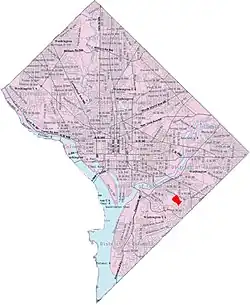 Skyland within the District of Columbia
Skyland within the District of Columbia
Skyland is a neighborhood in Southeast Washington, D.C. It is bounded by Good Hope Road to the northeast, Alabama Avenue to the southeast, and Fort Stanton Park to the south and west. It is part of Ward 8. (Full article...) -
 Image 2
Image 2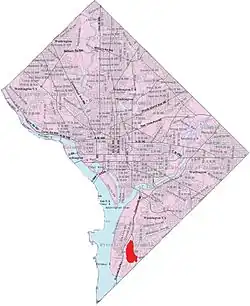 Bellevue within Washington, D.C.
Bellevue within Washington, D.C.
Bellevue is a residential neighborhood in far Southeast and Southwest in Washington, D.C., United States. It is bounded by South Capitol Street, one block of Atlantic Street SE, and 1st Streets SE and SW to the north and east; Joliet Street SW and Oxon Run Parkway to the south; Martin Luther King Jr. Avenue SE, Shepherd Parkway, 2nd Street SW, and Xenia Street SW to the west. Bellevue was created from some of the earliest land patents in Maryland, and draws its name from a 1795 mansion built in the area. Subdivisions began in the 1870s, but extensive residential building did not occur until the early 1940s. Bellevue is adjacent to a number of federal and city agency buildings. (Full article...) -
 Image 3
Image 3
Park View is a neighborhood in Washington, D.C., located in Northwest D.C. The neighborhood is primarily residential with its main commercial corridor of shops and restauarants located along Georgia Avenue. (Full article...) -
 Image 4
Image 4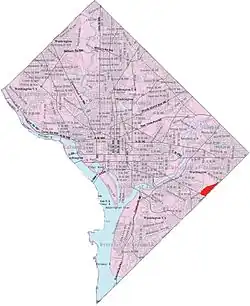 Map of Washington, D.C., with the Fort Davis neighborhood highlighted in red
Map of Washington, D.C., with the Fort Davis neighborhood highlighted in red
Fort Davis is a residential neighborhood located in southeast Washington, D.C., on the border between the District of Columbia and Maryland. It is bounded by Southern Avenue, Pennsylvania Avenue SE, and Alabama Avenue SE/Bowen Road SE. (Full article...) -
 Image 5
Image 5
Chevy Chase (/ˈtʃɛviː tʃeɪs/) is a neighborhood in northwest Washington, D.C. It borders Chevy Chase, Maryland. (Full article...) -
 Image 6
Image 6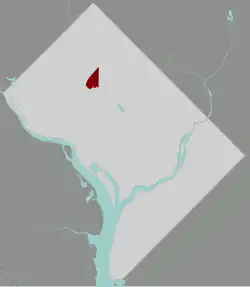
Map of Washington, D.C., with Crestwood highlighted in maroon
Crestwood is an entirely residential neighborhood located in Northwest Washington, D.C., and bordered on three sides by Rock Creek Park. Heading north from the White House on 16th Street, Crestwood is among the first neighborhoods that features single-family homes with larger lawns. It has many mature trees, and it is not uncommon to see deer and other wildlife from the park crossing the streets there. (Full article...) -
 Image 7
Image 7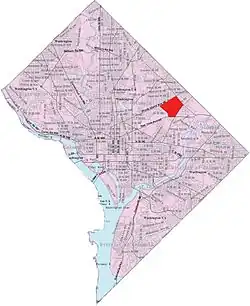 Langdon within the District of Columbia
Langdon within the District of Columbia
Langdon, is a neighborhood located in Ward 5 of Northeast Washington, D.C. Historical surveys of D.C. recognize Langdon as a neighborhood dating back to at least 1903. Langdon is bounded by Montana Ave. NE to the west/southwest, New York Ave. NE to the south, Bladensburg Rd. NE to the southeast, South Dakota Ave. NE to the northeast, and Rhode Island Ave. NE to the north/northwest. Langdon is adjacent to the Northeast D.C. neighborhoods of Brentwood (west), Woodridge (east), Fort Lincoln (southeast), Gateway (south), and Brookland (north). (Full article...) -
 Image 8
Image 8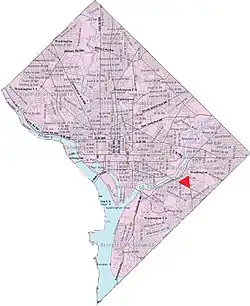 Twining within the District of Columbia
Twining within the District of Columbia
Twining is a neighborhood in Southeast Washington, D.C., near the eastern bank of the Anacostia River. It is bounded by Minnesota Avenue NE to the northeast, Branch Avenue to the northwest, and Pennsylvania Avenue to the south. The Fort Dupont year-round ice skating rink, and the Smithsonian Anacostia Community Museum are nearby. (Full article...) -
 Image 9
Image 9_(cropped).jpg)
Mount Pleasant is a neighborhood in Washington, D.C., located in Northwest D.C. The neighborhood is primarily residential, with restaurants and stores centered along a commercial corridor on Mt. Pleasant Street. Mount Pleasant is known for its unique identity and multicultural landscape, home to diverse groups such as the punk rock, the Peace Corps and Hispanic Washingtonian communities. (Full article...) -
 Image 10
Image 10.jpg) Bank of Brightwood building
Bank of Brightwood building
Brightwood is a neighborhood in the northwestern quadrant of Washington, D.C. Brightwood is part of Ward 4. (Full article...) -
 Image 11
Image 11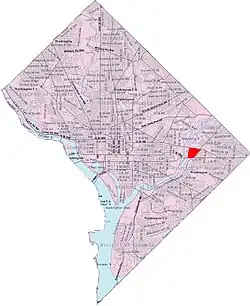 Map of Washington, D.C., with the River Terrace neighborhood highlighted in red
Map of Washington, D.C., with the River Terrace neighborhood highlighted in red
River Terrace is an urban cul-de-sac neighborhood in Northeast Bounded by Anacostia Riverwalk Trail NE, East Capitol Street NE, Kenilworth Avenue NE, and Benning Road NE.Washington, D.C., on the eastern bank of the Anacostia River. River Terrace is Washington, DC's only planned unit development that has an unimpeded connection to and relationship with the Anacostia River. (Full article...) -
 Image 12
Image 12
NoMa (short for "north of Massachusetts Avenue") is a neighborhood of Washington, D.C., located in Ward 6 of the city. The neighborhood encompasses the region north of Massachusetts Avenue located north and east of Union Station. It includes the Sursum Corda, Eckington, and Near Northeast areas, as well as a section known as Swampoodle. (Full article...) -
 Image 13
Image 13
Downtown is the central business district of Washington, D.C., located in Northwest D.C. It is the third largest central business district in the United States. The "Traditional Downtown" has been defined as an area roughly between Union Station in the east and 16th Street NW in the west, and between the National Mall on the south and Massachusetts Avenue on the north, including Penn Quarter. However, nowadays, Downtown D.C. can often refer to a larger area, as the DC Office of Planning states:
ِِِA small portion of this area is known as the Downtown Historic District and was listed on the NRHP in 2001. (Full article...)…most residents, workers, and visitors think of Downtown in a broader sense — including areas as far north as Dupont Circle, as far west as Foggy Bottom, and as far east as Capitol Hill. Only about half of the central city workforce is located within the city’s traditional Downtown.
Selected image
-
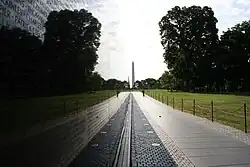 Image 1The Vietnam Veterans Memorial, a two-acre (8,100 m2) site featuring two black granite walls engraved with the names of those service members who died or remain missing in the Vietnam War designed by Maya Lin, was initially controversial for its lack of heroic iconography, a departure from earlier memorial designs. (from Washington, D.C.)
Image 1The Vietnam Veterans Memorial, a two-acre (8,100 m2) site featuring two black granite walls engraved with the names of those service members who died or remain missing in the Vietnam War designed by Maya Lin, was initially controversial for its lack of heroic iconography, a departure from earlier memorial designs. (from Washington, D.C.) -
 Image 2The Concert for Valor on the National Mall on November 11, 2014, looking west from the U.S. Capitol grounds (from National Mall)
Image 2The Concert for Valor on the National Mall on November 11, 2014, looking west from the U.S. Capitol grounds (from National Mall) -
 Image 3One Franklin Square in Downtown houses the headquarters of The Washington Post, the nation's third-largest newspaper by circulation as of 2023 (from Washington, D.C.)
Image 3One Franklin Square in Downtown houses the headquarters of The Washington Post, the nation's third-largest newspaper by circulation as of 2023 (from Washington, D.C.) -
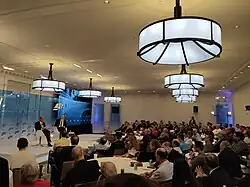 Image 4A panel discussion at the American Enterprise Institute, one of the city's many think tanks (from Washington, D.C.)
Image 4A panel discussion at the American Enterprise Institute, one of the city's many think tanks (from Washington, D.C.) -
 Image 5The French ambassador's residence in the Sheridan-Kalorama Historic District (from Washington, D.C.)
Image 5The French ambassador's residence in the Sheridan-Kalorama Historic District (from Washington, D.C.) -
 Image 6The Blue Plains Advanced Wastewater Treatment Plant in D.C. is the largest advanced wastewater treatment facility in the world. (from Washington, D.C.)
Image 6The Blue Plains Advanced Wastewater Treatment Plant in D.C. is the largest advanced wastewater treatment facility in the world. (from Washington, D.C.) -
Image 7John F. Kennedy Center for the Performing Arts (from National Mall)
-
 Image 8Washington Metro, the second-busiest rapid rail system in the U.S. based on average weekday ridership, is known for its iconic vaulted ceilings (from Washington, D.C.)
Image 8Washington Metro, the second-busiest rapid rail system in the U.S. based on average weekday ridership, is known for its iconic vaulted ceilings (from Washington, D.C.) -
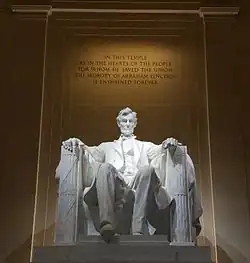
-
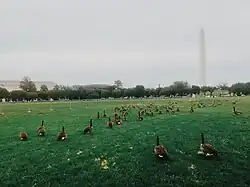 Image 10Axis after restoration (September 2016) (from National Mall)
Image 10Axis after restoration (September 2016) (from National Mall) -
.jpg)
-
 Image 12Map of the District of Columbia in 1835, prior to the retrocession (from History of Washington, D.C.)
Image 12Map of the District of Columbia in 1835, prior to the retrocession (from History of Washington, D.C.) -

-
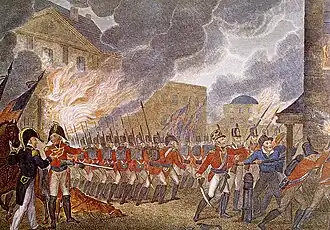 Image 14After their victory at the Battle of Bladensburg in 1814, the British Army burned the White House and other buildings during a one-day occupation of Washington, D.C. (from Washington, D.C.)
Image 14After their victory at the Battle of Bladensburg in 1814, the British Army burned the White House and other buildings during a one-day occupation of Washington, D.C. (from Washington, D.C.) -
 Image 15An 1814 watercolor illustration of the United States Capitol after the burning of Washington during the War of 1812 (from History of Washington, D.C.)
Image 15An 1814 watercolor illustration of the United States Capitol after the burning of Washington during the War of 1812 (from History of Washington, D.C.) -
_(cropped).jpg)
-
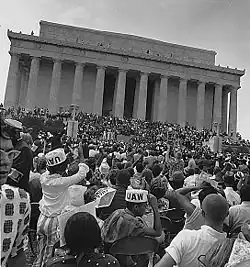 Image 17Civil rights marchers during the March on Washington at the Lincoln Memorial on August 28, 1963 (from History of Washington, D.C.)
Image 17Civil rights marchers during the March on Washington at the Lincoln Memorial on August 28, 1963 (from History of Washington, D.C.) -
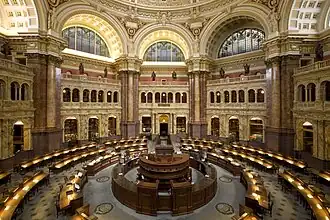 Image 18Reading Room at the Library of Congress (from National Mall)
Image 18Reading Room at the Library of Congress (from National Mall) -
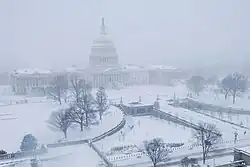 Image 19The U.S. Capitol during the February 5–6, 2010 North American blizzard (from Washington, D.C.)
Image 19The U.S. Capitol during the February 5–6, 2010 North American blizzard (from Washington, D.C.) -
 Image 20Reagan Washington National Airport in Arlington, Virginia is the closest airport to the city among the three major Washington metropolitan area airports. (from Washington, D.C.)
Image 20Reagan Washington National Airport in Arlington, Virginia is the closest airport to the city among the three major Washington metropolitan area airports. (from Washington, D.C.) -
 Image 21Pool after reconstruction (May 2016) (from National Mall)
Image 21Pool after reconstruction (May 2016) (from National Mall) -
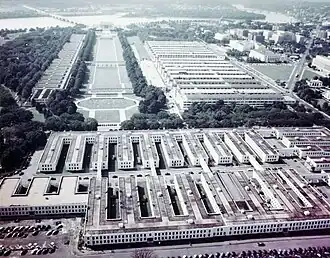 Image 22Westward view from the top of the Washington Monument in 1943 or 1944 during World War II. In the foreground, temporary buildings on the Washington Monument grounds house the Navy's Bureau of Ships. The Main Navy and Munitions Buildings stand to the right of the Lincoln Memorial Reflecting Pool. Temporary buildings to the left of the Reflecting Pool house the Navy's Bureau of Supplies and Accounts. (from National Mall)
Image 22Westward view from the top of the Washington Monument in 1943 or 1944 during World War II. In the foreground, temporary buildings on the Washington Monument grounds house the Navy's Bureau of Ships. The Main Navy and Munitions Buildings stand to the right of the Lincoln Memorial Reflecting Pool. Temporary buildings to the left of the Reflecting Pool house the Navy's Bureau of Supplies and Accounts. (from National Mall) -
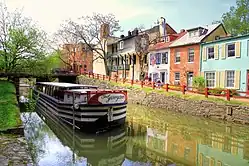
-
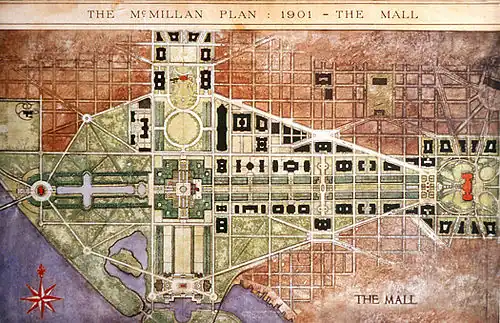 Image 24The National Mall, including a central pathway through it, the centerpiece of the 1901 McMillan Plan (from History of Washington, D.C.)
Image 24The National Mall, including a central pathway through it, the centerpiece of the 1901 McMillan Plan (from History of Washington, D.C.) -
 Image 25A major bus strike in May 1974 caused huge traffic jams throughout the city (from History of Washington, D.C.)
Image 25A major bus strike in May 1974 caused huge traffic jams throughout the city (from History of Washington, D.C.) -
.png) Image 26Map of racial distribution in the Washington metropolitan area, according to the 2010 U.S. census; each dot represents 25 people: White, Black, Asian, Hispanic or Other (yellow) (from Washington, D.C.)
Image 26Map of racial distribution in the Washington metropolitan area, according to the 2010 U.S. census; each dot represents 25 people: White, Black, Asian, Hispanic or Other (yellow) (from Washington, D.C.) -
.jpg)
-
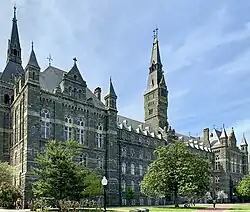 Image 28Georgetown University, founded in 1789, the city's oldest university (from Washington, D.C.)
Image 28Georgetown University, founded in 1789, the city's oldest university (from Washington, D.C.) -
.jpg)
-
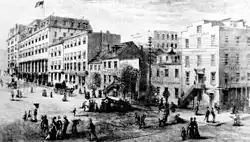
-
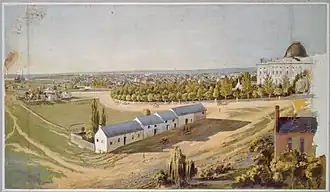 Image 31Portrait of the Mall and vicinity looking northwest from southeast of the U.S. Capitol, circa 1846–1855, showing stables in the foreground, the Washington City Canal behind them, the Capitol on the right and the Smithsonian "Castle", the Washington Monument and the Potomac River in the distant left. (from National Mall)
Image 31Portrait of the Mall and vicinity looking northwest from southeast of the U.S. Capitol, circa 1846–1855, showing stables in the foreground, the Washington City Canal behind them, the Capitol on the right and the Smithsonian "Castle", the Washington Monument and the Potomac River in the distant left. (from National Mall) -
Image 32The World War II Memorial, one of many popular tourist sites located on the National Mall (from Washington, D.C.)
-
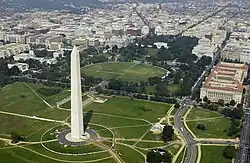 Image 33The Washington Monument (forefront) and White House (center) in September 2003. Since 1961, the city's residents can vote for the U.S. president and vice president, who also serves as President of the Senate. (from Washington, D.C.)
Image 33The Washington Monument (forefront) and White House (center) in September 2003. Since 1961, the city's residents can vote for the U.S. president and vice president, who also serves as President of the Senate. (from Washington, D.C.) -
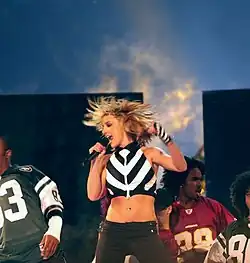 Image 34Britney Spears performs during the "NFL Kickoff Live from the National Mall Presented by Pepsi Vanilla" concert, September 4, 2003 (from National Mall)
Image 34Britney Spears performs during the "NFL Kickoff Live from the National Mall Presented by Pepsi Vanilla" concert, September 4, 2003 (from National Mall) -
_NE_4.jpg) Image 35The Northeast Boundary No. 4 marker stone of the original border between the District of Columbia and Prince George's County, Maryland (from History of Washington, D.C.)
Image 35The Northeast Boundary No. 4 marker stone of the original border between the District of Columbia and Prince George's County, Maryland (from History of Washington, D.C.) -
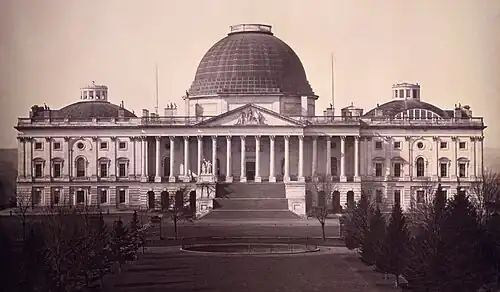 Image 36The United States Capitol in 1846, prior to the addition of the current rotunda (from History of Washington, D.C.)
Image 36The United States Capitol in 1846, prior to the addition of the current rotunda (from History of Washington, D.C.) -
Image 37The Aqueduct Bridge crossing the Potomac River, with Northern Virginia in the background and the Chesapeake and Ohio Canal in the foreground (from History of Washington, D.C.)
-
 Image 38Demonstrators marching down Pennsylvania Avenue towards the United States Capitol on January 6, 2021 (from History of Washington, D.C.)
Image 38Demonstrators marching down Pennsylvania Avenue towards the United States Capitol on January 6, 2021 (from History of Washington, D.C.) -
 Image 39The Library of Congress, the world's largest library, has more than 173 million items. (from Washington, D.C.)
Image 39The Library of Congress, the world's largest library, has more than 173 million items. (from Washington, D.C.) -
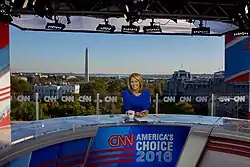 Image 40CNN reporting from the city during the 2016 U.S. presidential election (from Washington, D.C.)
Image 40CNN reporting from the city during the 2016 U.S. presidential election (from Washington, D.C.) -
_(cropped).jpg) Image 41Duke Ellington School of the Arts, a public magnet school in the city (from Washington, D.C.)
Image 41Duke Ellington School of the Arts, a public magnet school in the city (from Washington, D.C.) -
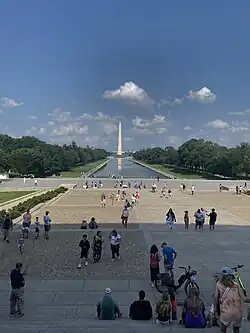 Image 42The National Mall viewed from the Lincoln Memorial, July 2023 (from National Mall)
Image 42The National Mall viewed from the Lincoln Memorial, July 2023 (from National Mall) -
.jpg)
-
 Image 44The National Mall was the centerpiece of the 1902 McMillan Plan. A central open vista traversed the length of the Mall. (from National Mall)
Image 44The National Mall was the centerpiece of the 1902 McMillan Plan. A central open vista traversed the length of the Mall. (from National Mall) -

-
.jpg) Image 46Lincoln Memorial Reflecting Pool before reconstruction (April 2010) (from National Mall)
Image 46Lincoln Memorial Reflecting Pool before reconstruction (April 2010) (from National Mall) -
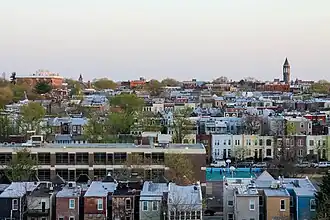
-
.jpg)
-
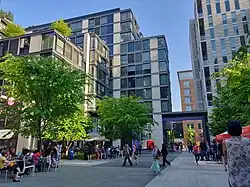
-

-
 Image 51General Dwight D. Eisenhower received a hero's welcome in the city in June 1945 following the Allied victory in World War II (from History of Washington, D.C.)
Image 51General Dwight D. Eisenhower received a hero's welcome in the city in June 1945 following the Allied victory in World War II (from History of Washington, D.C.) -
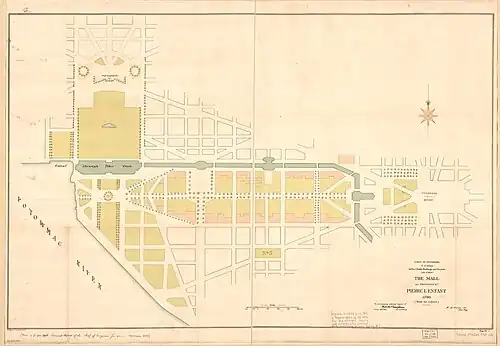 Image 52Library of Congress(from National Mall)
Image 52Library of Congress(from National Mall)
The "Grand Avenue" or Mall as proposed by Pierre L'Enfant, 1791 -
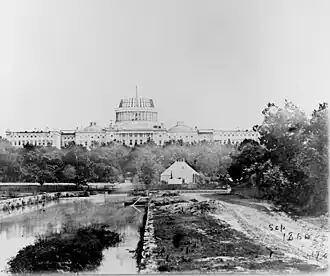 Image 53President Abraham Lincoln insisted that construction of the United States Capitol continue during the Civil War. (from History of Washington, D.C.)
Image 53President Abraham Lincoln insisted that construction of the United States Capitol continue during the Civil War. (from History of Washington, D.C.) -
.jpg)
-
.tiff.jpg) Image 55Federal Triangle, a historic hub of executive departments of the U.S. federal government (from Washington, D.C.)
Image 55Federal Triangle, a historic hub of executive departments of the U.S. federal government (from Washington, D.C.) -
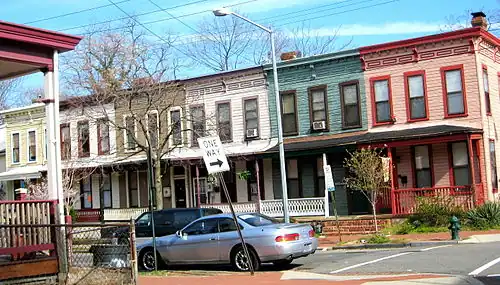
-
 Image 57The Pentagon following the September 11 attacks with the Washington Monument visible in the background (from History of Washington, D.C.)
Image 57The Pentagon following the September 11 attacks with the Washington Monument visible in the background (from History of Washington, D.C.) -
-
.jpg) Image 59Pennsylvania Avenue, one of the city's most prominent streets, connects the U.S. Capitol and White House. (from Washington, D.C.)
Image 59Pennsylvania Avenue, one of the city's most prominent streets, connects the U.S. Capitol and White House. (from Washington, D.C.) -
.jpg) Image 60The Eisenhower Executive Office Building, built between 1871 and 1888, was the world's largest office building until 1943, when it was surpassed by The Pentagon. (from Washington, D.C.)
Image 60The Eisenhower Executive Office Building, built between 1871 and 1888, was the world's largest office building until 1943, when it was surpassed by The Pentagon. (from Washington, D.C.) -
 Image 61The Jefferson Memorial and many of the city's other major monuments are built in the Neoclassical style. (from Washington, D.C.)
Image 61The Jefferson Memorial and many of the city's other major monuments are built in the Neoclassical style. (from Washington, D.C.) -
.jpg)
-
 Image 63A performance of Moulin Rouge! at the Kennedy Center for the Performing Arts (from Washington, D.C.)
Image 63A performance of Moulin Rouge! at the Kennedy Center for the Performing Arts (from Washington, D.C.) -
.jpg)
-
Image 65Facing east on the National Mall, as viewed near the 1300 block of Jefferson Drive, S.W. in April 2010. Rows of American elm trees line the sides of a path traversing the length of the Mall. (from National Mall)
-
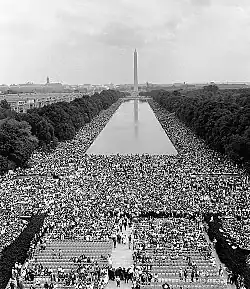 Image 66The March on Washington at the Lincoln Memorial Reflecting Pool on August 28, 1963 (from Washington, D.C.)
Image 66The March on Washington at the Lincoln Memorial Reflecting Pool on August 28, 1963 (from Washington, D.C.) -
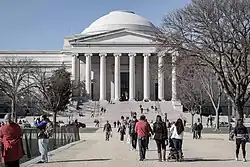 Image 67The National Gallery of Art, the fourth-most visited art museum in the United States in 2023 with nearly four million visitors (from Washington, D.C.)
Image 67The National Gallery of Art, the fourth-most visited art museum in the United States in 2023 with nearly four million visitors (from Washington, D.C.) -
 Image 68Due to limited dining options on the Mall, food trucks are often parked next to tourist-dense locations. (from National Mall)
Image 68Due to limited dining options on the Mall, food trucks are often parked next to tourist-dense locations. (from National Mall) -
 Image 69Metrobus, operated by the Washington Metropolitan Area Transit Authority (from Washington, D.C.)
Image 69Metrobus, operated by the Washington Metropolitan Area Transit Authority (from Washington, D.C.) -
 Image 70Eastward view of the National Mall from the top of the Washington Monument in 1918. The three structures and two chimneys crossing the Mall are temporary World War I buildings A, B and C and parts of their central power plant. (from National Mall)
Image 70Eastward view of the National Mall from the top of the Washington Monument in 1918. The three structures and two chimneys crossing the Mall are temporary World War I buildings A, B and C and parts of their central power plant. (from National Mall) -
.jpg)
-
 Image 72The Washington Monument stood in this unfinished form for 25 years before being completed in 1884. Upon its completion, it was the tallest man-made structure in the world. (from History of Washington, D.C.)
Image 72The Washington Monument stood in this unfinished form for 25 years before being completed in 1884. Upon its completion, it was the tallest man-made structure in the world. (from History of Washington, D.C.) -
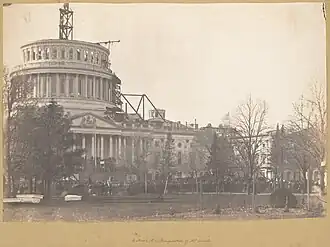 Image 73The U.S. Capitol dome was under construction during Lincoln's first inauguration on March 4, 1861, five weeks before the start of the American Civil War. (from Washington, D.C.)
Image 73The U.S. Capitol dome was under construction during Lincoln's first inauguration on March 4, 1861, five weeks before the start of the American Civil War. (from Washington, D.C.) -
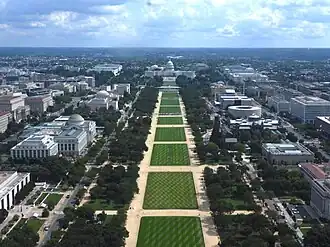 Image 74Looking east from the top of the Washington Monument towards the Mall and the U.S. Capitol, 2023 (from National Mall)
Image 74Looking east from the top of the Washington Monument towards the Mall and the U.S. Capitol, 2023 (from National Mall) -
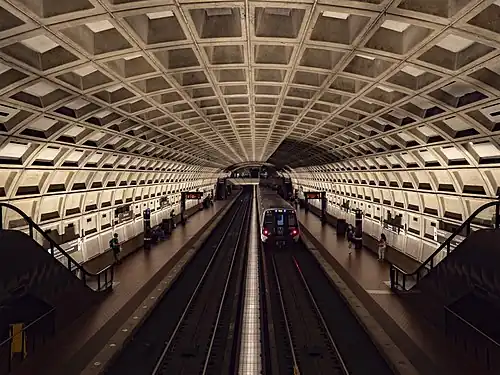
-
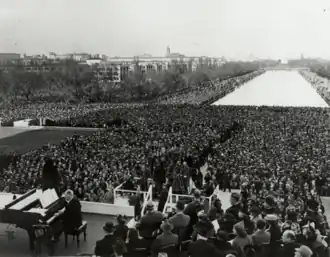 Image 76The April 9, 1939, concert by Marian Anderson, facing east from the Lincoln Memorial (from National Mall)
Image 76The April 9, 1939, concert by Marian Anderson, facing east from the Lincoln Memorial (from National Mall) -
 Image 77The city's license plate, which calls for an end to taxation without representation (from Washington, D.C.)
Image 77The city's license plate, which calls for an end to taxation without representation (from Washington, D.C.) -
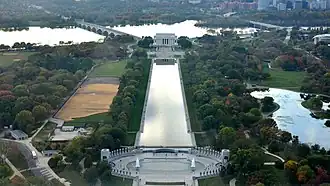 Image 78This view from the top of the Washington Monument shows rows of elm trees lining the Reflecting Pool (November 2014). (from National Mall)
Image 78This view from the top of the Washington Monument shows rows of elm trees lining the Reflecting Pool (November 2014). (from National Mall) -
 Image 79City of Washington from Beyond the Navy Yard, an 1833 portrait by George Cooke in the Oval Office in the White House (from History of Washington, D.C.)
Image 79City of Washington from Beyond the Navy Yard, an 1833 portrait by George Cooke in the Oval Office in the White House (from History of Washington, D.C.) -
.jpg) Image 80Eisenhower Memorial at night, 2021 (from National Mall)
Image 80Eisenhower Memorial at night, 2021 (from National Mall) -
_(cropped).jpg) Image 81The Eccles Building on Constitution Avenue, home of the Federal Reserve, the central bank of the United States (from Washington, D.C.)
Image 81The Eccles Building on Constitution Avenue, home of the Federal Reserve, the central bank of the United States (from Washington, D.C.) -
.jpg) Image 82West side of the U.S. Capitol building (March 2019) (from National Mall)
Image 82West side of the U.S. Capitol building (March 2019) (from National Mall) -
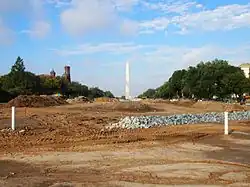 Image 83Axis undergoing restoration (October 2015) (from National Mall)
Image 83Axis undergoing restoration (October 2015) (from National Mall) -
Image 842009 view from the United States Capitol facing west, over the Grant Memorial and Capitol Reflecting Pool in the foreground, and across the National Mall towards the Washington Monument (from National Mall)
-
 Image 85The Washington Monument viewed from the Tidal Basin during the National Cherry Blossom Festival in April 2018 (from Washington, D.C.)
Image 85The Washington Monument viewed from the Tidal Basin during the National Cherry Blossom Festival in April 2018 (from Washington, D.C.) -
.jpg) Image 86The Mall following a snow storm (from National Mall)
Image 86The Mall following a snow storm (from National Mall) -
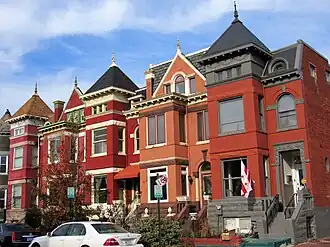
-
-
.jpg) Image 89Rock Creek Park, the city's largest park, stretches across Northwest. (from Washington, D.C.)
Image 89Rock Creek Park, the city's largest park, stretches across Northwest. (from Washington, D.C.) -

-
-
_satellite_image.jpg) Image 92National Mall proper and adjacent areas (April 2002). The Mall had a grassy lawn flanked on each side by unpaved paths and rows of American elm trees as its central feature. (Numbers in the image correspond to numbers in the list of landmarks, museums and other features below.) (from National Mall)
Image 92National Mall proper and adjacent areas (April 2002). The Mall had a grassy lawn flanked on each side by unpaved paths and rows of American elm trees as its central feature. (Numbers in the image correspond to numbers in the list of landmarks, museums and other features below.) (from National Mall) -
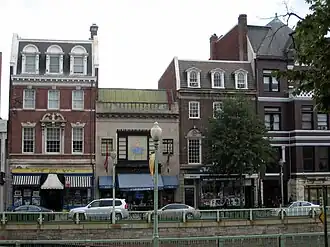
-
.jpg) Image 94Washington, D.C., police on Harley-Davidson motorcycles escorting the March for Life protest on Constitution Avenue in January 2018 (from Washington, D.C.)
Image 94Washington, D.C., police on Harley-Davidson motorcycles escorting the March for Life protest on Constitution Avenue in January 2018 (from Washington, D.C.) -
.jpg) Image 95Rows of young American elm trees on the National Mall, looking east from the top of the Washington Monument, circa 1942 (from National Mall)
Image 95Rows of young American elm trees on the National Mall, looking east from the top of the Washington Monument, circa 1942 (from National Mall) -
 Image 96The city's African American population has declined since the 1968 riots. (from Washington, D.C.)
Image 96The city's African American population has declined since the 1968 riots. (from Washington, D.C.) -
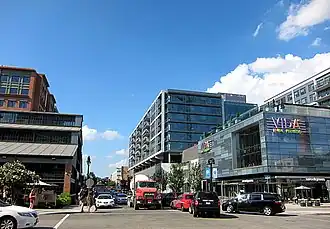
-
.jpg) Image 98The L'Enfant Plan for the city, developed in 1791 by Pierre Charles L'Enfant (from Washington, D.C.)
Image 98The L'Enfant Plan for the city, developed in 1791 by Pierre Charles L'Enfant (from Washington, D.C.) -
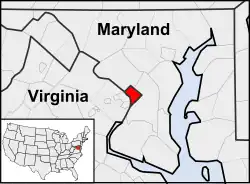 Image 99Washington, D.C. is located on the north side of the Potomac River. It is bordered on three sides by Maryland and by Northern Virginia to its southwest. (from Washington, D.C.)
Image 99Washington, D.C. is located on the north side of the Potomac River. It is bordered on three sides by Maryland and by Northern Virginia to its southwest. (from Washington, D.C.) -
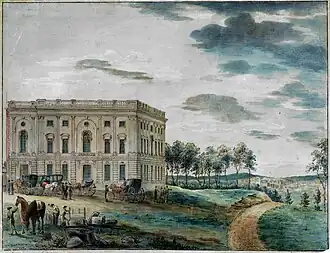 Image 100In 1800, the United States Congress began assembling in the new United States Capitol after the nation's capital was moved from Philadelphia, which served as the capital during the American Revolution and again from 1790 to 1800. (from Washington, D.C.)
Image 100In 1800, the United States Congress began assembling in the new United States Capitol after the nation's capital was moved from Philadelphia, which served as the capital during the American Revolution and again from 1790 to 1800. (from Washington, D.C.) -
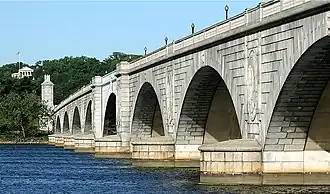 Image 101Memorial Bridge, connecting the city across the Potomac River with Arlington County (from Washington, D.C.)
Image 101Memorial Bridge, connecting the city across the Potomac River with Arlington County (from Washington, D.C.) -
 Image 102With over 30,000 participants as of 2024, the annual Marine Corps Marathon, held annually in October in Washington, D.C. and Arlington County, is the largest non-prize money marathon in the country. (from Washington, D.C.)
Image 102With over 30,000 participants as of 2024, the annual Marine Corps Marathon, held annually in October in Washington, D.C. and Arlington County, is the largest non-prize money marathon in the country. (from Washington, D.C.) -
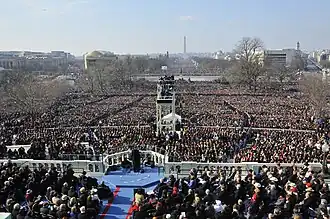 Image 103The first inauguration of Barack Obama on January 20, 2009, facing west from the Capitol (from National Mall)
Image 103The first inauguration of Barack Obama on January 20, 2009, facing west from the Capitol (from National Mall) -

-
 Image 105The southern portion of the National Mall in 1863 during the American Civil War (from History of Washington, D.C.)
Image 105The southern portion of the National Mall in 1863 during the American Civil War (from History of Washington, D.C.) -
.jpg) Image 106Ben's Chili Bowl on U Street, known for its half-smoke, a historic staple of the city's cuisine (from Washington, D.C.)
Image 106Ben's Chili Bowl on U Street, known for its half-smoke, a historic staple of the city's cuisine (from Washington, D.C.) -
 Image 107Construction of the Washington Metro on Connecticut Avenue in 1973 (from History of Washington, D.C.)
Image 107Construction of the Washington Metro on Connecticut Avenue in 1973 (from History of Washington, D.C.) -
%252C_b._1850.jpg) Image 108On September 18, 1783, an engraving of George Washington, known as the First Cornerstone, was placed as the corner stone of the United States Capitol. (from History of Washington, D.C.)
Image 108On September 18, 1783, an engraving of George Washington, known as the First Cornerstone, was placed as the corner stone of the United States Capitol. (from History of Washington, D.C.) -
 Image 1091963 March on Washington for Jobs and Freedom on the National Mall facing east from the Lincoln Memorial (from National Mall)
Image 1091963 March on Washington for Jobs and Freedom on the National Mall facing east from the Lincoln Memorial (from National Mall) -
.jpg) Image 110Capital One Arena in the city's Chinatown section hosts the Washington Capitals, an NHL team (pictured), and the Washington Wizards, an NBA team (from Washington, D.C.)
Image 110Capital One Arena in the city's Chinatown section hosts the Washington Capitals, an NHL team (pictured), and the Washington Wizards, an NBA team (from Washington, D.C.) -
Image 111National Mall, a landscaped park extending from the Lincoln Memorial to the United States Capitol (from Washington, D.C.)
-
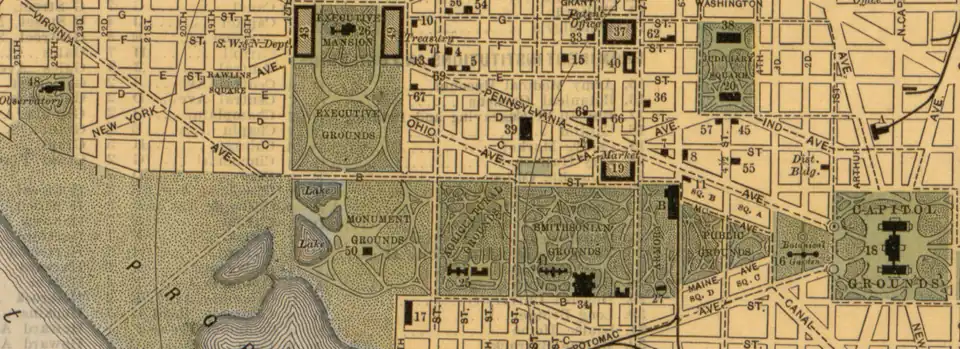 Image 112Map of the Mall in 1893 showing the Monument Grounds (with the Washington Monument), Agricultural Grounds (with the Dept. of Agriculture), Smithsonian Grounds (with the Castle and Arts and Industries museum), Armory Square, Public Grounds and Botanical Garden, as well as parts of the recently created "Tidal Reservoir" and "Proposed Park" (from National Mall)
Image 112Map of the Mall in 1893 showing the Monument Grounds (with the Washington Monument), Agricultural Grounds (with the Dept. of Agriculture), Smithsonian Grounds (with the Castle and Arts and Industries museum), Armory Square, Public Grounds and Botanical Garden, as well as parts of the recently created "Tidal Reservoir" and "Proposed Park" (from National Mall) -
 Image 113The John A. Wilson Building on Pennsylvania Avenue, headquarters for much of the Government of the District of Columbia, including the offices of the mayor and D.C. Council (from Washington, D.C.)
Image 113The John A. Wilson Building on Pennsylvania Avenue, headquarters for much of the Government of the District of Columbia, including the offices of the mayor and D.C. Council (from Washington, D.C.) -
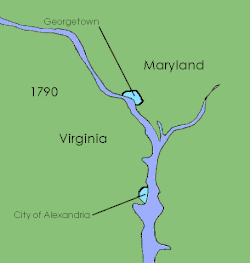 Image 114Territorial progression of Washington, D.C. (from History of Washington, D.C.)
Image 114Territorial progression of Washington, D.C. (from History of Washington, D.C.) -
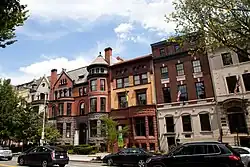
-
.jpg) Image 116The National Museum of Natural History, the third-most visited museum in the U.S. in 2023, with 4.4 million visitors (from Washington, D.C.)
Image 116The National Museum of Natural History, the third-most visited museum in the U.S. in 2023, with 4.4 million visitors (from Washington, D.C.)
Did you know...
- ... that in one neighborhood commission district, the voters and officeholders are all inmates at the D.C. Jail?
- ... that the Washington D.C. Temple was moved 60 feet (18 m) to exactly align with a nearby road?
- ... that Leonardo DiCaprio was set to star in the film adaptation of Leonardo da Vinci?
- ... that a coconut tree meme drove sales of piña coladas in the Washington, D.C., area?
- ... that Bicentennial Capitol Mall State Park, modeled on the National Mall in Washington, D.C., was created to commemorate the 200th anniversary of the statehood of Tennessee in 1996?
- ... that of more than 300 schools offering evening classes in the District of Columbia in 1907, only Frelinghuysen University admitted Black students?
In the news
- 18 August 2025 – Russian invasion of Ukraine
- Ukrainian president Volodymyr Zelenskyy and several other European leaders meet with U.S. president Donald Trump at the White House in Washington, D.C. to discuss pathways to peace negotiations for the Russian invasion of Ukraine. (Al Jazeera)
- 11 August 2025 –
- U.S. president Donald Trump places the Metropolitan Police Department of the District of Columbia under federal government-control and orders 800 National Guard troops to enter Washington, D.C., allegedly to fight rising crime rates. (Reuters)
- 8 August 2025 – Armenia–Azerbaijan relations
- The leaders of Armenia and Azerbaijan plan to sign a joint declaration at the White House in Washington, D.C., United States, committing to a peace deal facilitated by the Trump administration that would end nearly four decades of conflict between the two countries. (CNN)
- 29 July 2025 – Kivu conflict
- Wazalendo militia Human Rights Defense Forces and M23 rebels clash on a hill near Kazinga, Masisi Territory, Democratic Republic of the Congo (DRC). (Radio Okapi)
- 29 July 2025 – Ituri conflict
- Zaïre-FPAC militants attack Sanduku 1, Djugu Territory, DRC, killing two civilians. (Radio Okapi)
- 25 July 2025 – Ituri conflict
- Two Mai-Mai militias continue to fight over the control of agricultural roads in Babila-Babombi chiefdom, Mambasa Territory, DRC. Residents of several villages flee to escape the fighting. (Radio Okapi)
Categories
- Select [►] to view subcategories
Topics
| Topics |
|
|---|---|
| Government | |
| Services | |
| Society | |
| History |
|
Related portals
Related WikiProjects
- WikiProject District of Columbia (talk)
- WikiProject Cities (talk)
- WikiProject United States (talk)
Associated Wikimedia
The following Wikimedia Foundation sister projects provide more on this subject:
-
Commons
Free media repository -
Wikibooks
Free textbooks and manuals -
Wikidata
Free knowledge base -
Wikinews
Free-content news -
Wikiquote
Collection of quotations -
Wikisource
Free-content library -
Wikispecies
Directory of species -
Wikiversity
Free learning tools -
Wikivoyage
Free travel guide -
Wiktionary
Dictionary and thesaurus



